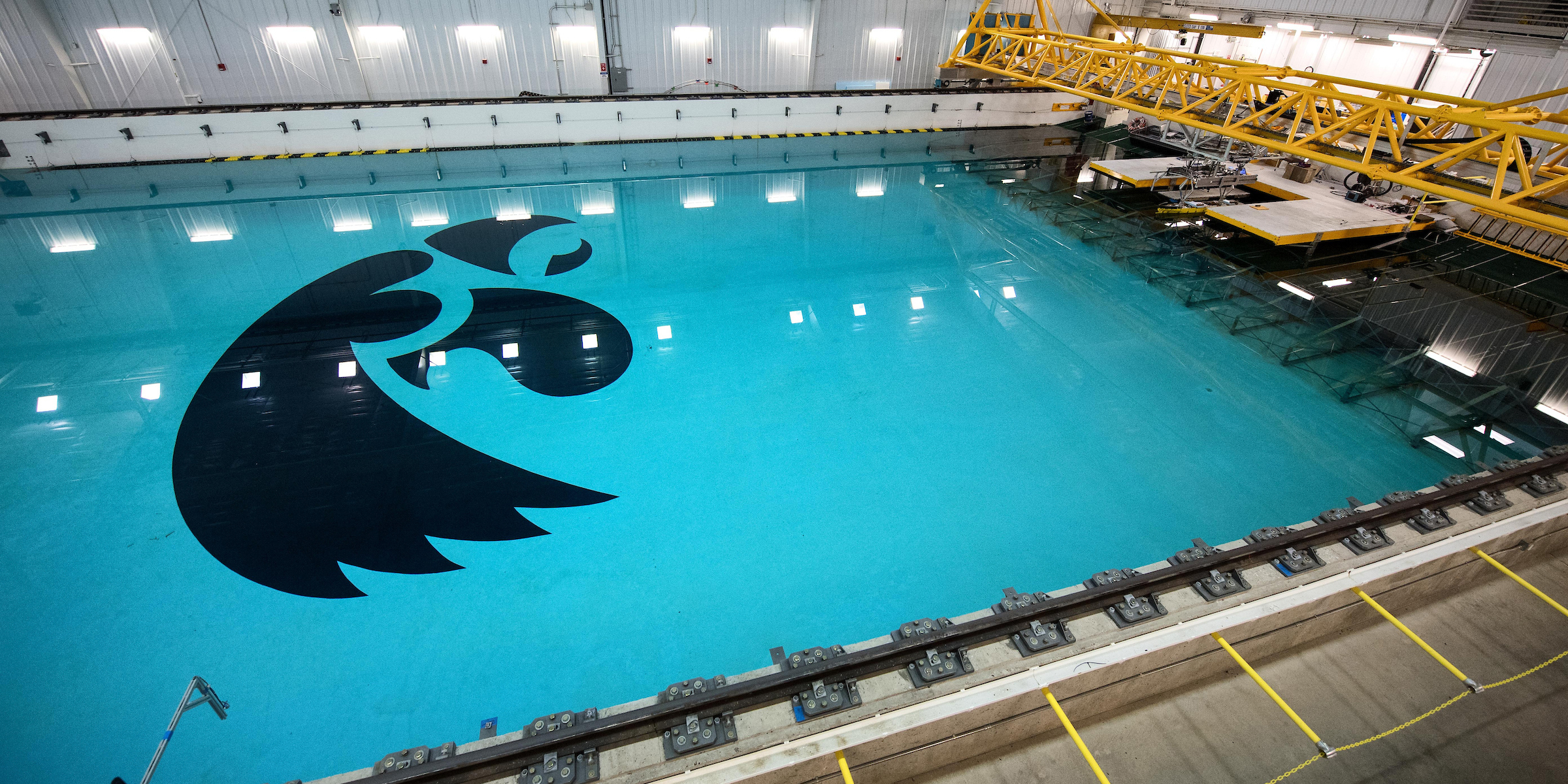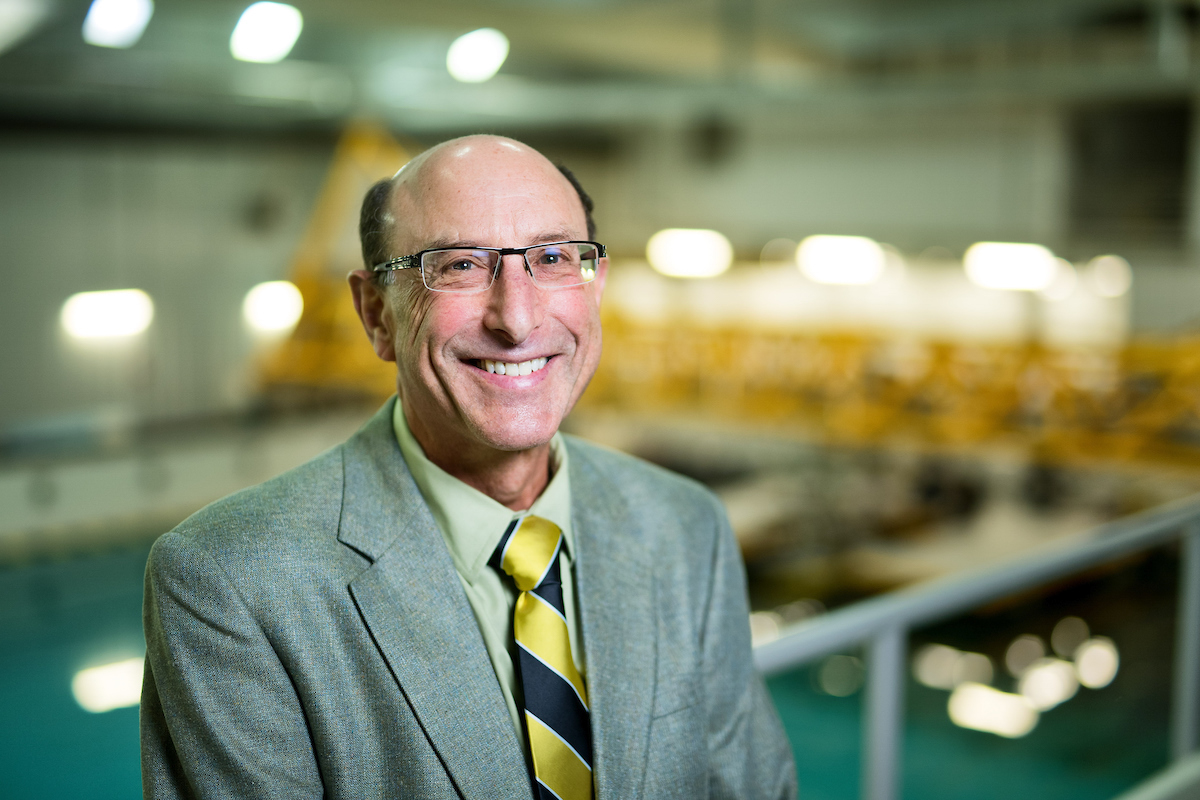Landlocked Iowa leads the world in ship hydrodynamics

Tucked away in the University of Iowa’s Research Park is one of the world’s most renowned wave basins—a warehouse-sized tank of water with the technology necessary for testing Navy and commercial ship designs years before the vessels are christened.
The UI’s Hydraulics Wave Basin Facility was constructed in 2010 under the guidance of Frederick Stern, a professor of mechanical and industrial engineering who, since his arrival at the UI in 1983, has built on the university’s impressive history of hydroscience and engineering research to create the gold standard of ship hydrodynamics programs.
Stern and his team of researchers and graduate students use simulation-based design, a sort of virtual reality of ship hydrodynamics, and scale-model experiments that support the design of modern, high-performance naval and commercial vessels. They do this in a laboratory that includes a basin 40 meters long, 20 meters wide, and 3 meters deep; six wave makers, and a custom, 8-ton overhead carriage with indoor global positioning and two-camera vision that tracks radio-controlled model ships as they battle various sea states. The free-moving ship models can move straight ahead, zigzag, make full circles, and capsize.
“We have to be precise because our reputation depends on it. The research we produce must withstand not only the physical forces of the world’s oceans, but also the intense scrutiny of our international peers and competitors.”

But this isn’t about playing with toy ships in an oversized swimming pool. Basin researchers work with the U.S. Office of Naval Research and hydrodynamics labs around the world to help tackle some of the most pressing issues in ship design, including reducing carbon emissions from naval and commercial fleets without compromising engine power, improving safety by reducing ship rollovers in turbulent seas, and making naval ships less vulnerable to detection and attack by enemy vessels.
“The UI Wave Basin Facility is very unique,” says Stern. “It’s also very sophisticated in that it provides an environment that mimics the sea so we can test ship designs in a very precise manner. We have to be precise because our reputation depends on it. The research we produce must withstand not only the physical forces of the world’s oceans, but also the intense scrutiny of our international peers and competitors.”
A big factor in that precision is a groundbreaking computer code that Stern and his team created through their research. CFDShip-Iowa simulates air and water flow around a virtual ship, allowing researchers to predict the ship’s performance under extreme environmental conditions without putting naval or commercial crews at risk. As one of the most advanced computational fluid dynamics computer codes in the world for ship hydrodynamics, CFDShip-Iowa is the code used by the U.S. Navy to evaluate ship design.
Once the code has been used to evaluate a virtual prototype, a physical model is created to conduct additional experiments, first in a towing tank—a smaller laboratory located at the UI’s IIHR—Hydroscience & Engineering building along the Iowa River—and later in the much larger wave basin, where a 3-D particle image velocimetry system measures fluid velocities around the ship models, facilitating the collection of detailed flow data.
“I don’t trust the CFD simulations or the wave basin model experiments until I see that both make complete sense and cross-validate each other,” Stern says. “We have found where the simulations showed us problems with the experiments. And, of course, we often find the limitations of our simulations based on the experimental data retained. You really need both to be sure that your results are correct.”
Looking to the future, Stern predicts that ship hydrodynamics will rely even more heavily on simulation-based design, and that the UI’s Hydraulics Wave Basin Facility will continue to serve as a leader in the field.
“At the University of Iowa, there’s a great enthusiasm for learning and research, not only in ship hydrodynamics but across the campus,” Stern says. “No matter where you go on campus, it’s never about doing the same thing over and over again, and that’s something that is very, very important to me.”
Learn more about hydroscience at the University of Iowa.













